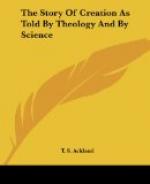The third defect noticed in the Nebular Hypothesis was, that it did not account for this motion of rotation. This defect, then, like the two preceding ones, is supplied by the Mosaic Record, and the hypothesis thus supplemented becomes complete. It is capable of giving a satisfactory account of the phenomena to which it applies. But as it is only a theory, and only points out a way in which the universe might have been constructed, it does not in itself exclude the possibility that some other plan might in fact have been adopted, and we have now to examine into the reasons for supposing that it was the method which was actually employed. These divide themselves into two classes:—those which render it probable that similar processes are now in progress; and those which render it probable that the solar system has passed through such a process.
It has already been pointed out that the great nebulae in Orion and Argo seem to represent the condition of our system on the first appearance of light, and that changes are strongly suspected to be taking place in both; but we cannot expect to trace any single nebula through the stages of its development, since that development must occupy untold ages. All we can do is to inquire if there are other nebulas which seem to be in more advanced stages. It must at once be recognized, that if this be one of the processes now going on, it is not the only one. There are many nebulas “which have assumed forms for which the law of gravitation, as we know it, will not enable us to account—such as the Ring Nebula in Lyra, the Dumb-bell Nebula in Vulpecula, or the double Horseshoe in Scutum Sobieski. But some nebulas can be found which arrange themselves so as to illustrate the stages through which we may suppose our world to have passed. These are chiefly to be found among the planetary nebulse, which in a small telescope exhibit a faint circular disc, but in larger instruments frequently show considerable varieties of structure. Some of them present the appearance of a condensation of light in the centre, which gradually fades off; in others there is a bright ring surrounding the central spot, but separated from it by a darker space. The Nebula Andromeda 49647, [Footnote: The numbers are those given by Sir J. Hersohel.] as seen in Mr. Lassel’s four-foot reflector appears as a luminous spot, surrounded by two luminous rings, which, in the more powerful instrument of Lord Bosse, combine into a spiral. Its spectrum is gaseous, with one line indicating some element unknown to us. In another nebula, Draco 4373, there is a double spectrum, the one gaseous, indicating the presence of hydrogen, nitrogen, and barium; the other, apparently from the nucleus, continuous, and so representing a solid or fluid mass, but so faint that the lines belonging to particular elements cannot be distinguished. [Footnote: Hugging, Philosophical Transactions, 1864.] Bridanus 846, and Andromeda 116, are probably similar nebulee occupying different positions




